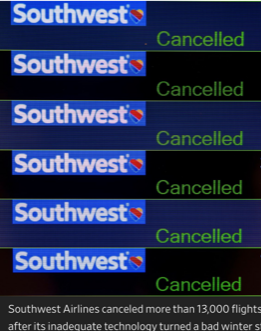Oh, how fast the mighty can fall.
In February of 2022, Southwest Airlines was named one of Forbes 2022 America’s Best Employers – their 7th time on this list SOUTHWEST AIRLINES ONCE AGAIN RANKED AMONG FORBES’ BEST EMPLOYERS IN AMERICA | Markets Insider (businessinsider.com).
As recently as March 2022, J.D. Powers ranked Southwest Airlines at the top of the list for Best Airlines in America (Economy/Basic Economy). Ranked: The Best Airlines In America In 2022, According To J.D. Power Report (forbes.com)
Now, with just a few days left in December, Southwest Airlines has a public relations nightmare on its hands. Though P.T. Barnum once said, “there’s no such thing as bad publicity,” CEO Robert Jordan would likely disagree, after facing the trifecta of difficult weather, inefficient (and reportedly ancient) operational systems and high travel traffic during the holidays.
The result? Angry customers unable to get to their destinations because of cancelled flights. Frustrated flight and ground crews – the same employees who would normally be positive ambassadors for the airline that has earned a reputation for putting employees first. Criticism from Transportation Secretary Pete Buttigieg who has said his agency would “examine the causes of Southwest’s widespread cancellations” and the Senate Commerce Committee who has also promised an investigation.
The fact is, it takes a long time to earn reputational trust, but just few days for that reputation to implode in the face of a crisis with no immediate solutions available. Today’s customers are wired to expect exceptional customer service and instant gratification – and it is management’s job to anticipate issues and move quickly to solve problems.
Beyond making the apology, which Jordan has already done, what steps can Southwest Airlines take to rectify this situation in the eyes of customers, employees, and regulators?
- Make taking care of customers a top priority. Compensate customers for their inconvenience (and make it easy for them to submit claims). Already there are Senate Democrats making noise about wanting SWA to provide “significant compensation” to stranded customers. Make decisions proactively on policies for reimbursements for hotel, rental cars, meals and other unexpected expenses customers assumed during this travel emergency. Give gate agents the ability to make decisions on the spot. Build relationships with other airlines to take your stranded customers when things go wrong.
- Determine what operational systems need upgrading and implement changes ASAP. After a crisis, key stakeholders will want to know what the problem(s) were and what you’ve done to solve them. Let employees, customers and regulators know the short-term and longer-term actions you are taking that will rebuild their confidence in the airline and help them serve as positive ambassadors down the road.
- Review the SWA crisis communication plan through the lens of “lessons learned” from the crisis at hand. Issues anticipation is a critical part of good crisis management – where can the crisis plan be strengthened? Are there additional scenarios (including preparing for the findings of the Congressional committees investigating SWA) for which the public relations team needs to prepare?
- SWA has one of the premier research teams in our industry, so they will undoubtedly continue to monitor media to determine the tone of the coverage – is it positive, negative or neutral? It’s important to continue other forms of “rolling research” including social media chatter, customer purchasing patterns (how much market share has been lost) and an increase or decrease in the number of customer complaints about SWA. Add to the list: research around industry best practices and customer “expectations”.
- An important question to ask: is management listening to what you are sharing? counseling? acting on it? If not, why not and what should done about that?
The SWA situation is a triggering event for all organizations to ask: how many of these practices and tactics are in place in your own organization?

